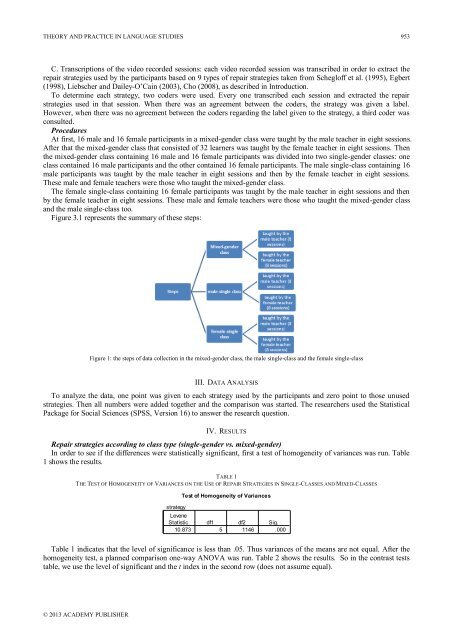Theory and Practice in Language Studies Contents - Academy ...
Theory and Practice in Language Studies Contents - Academy ...
Theory and Practice in Language Studies Contents - Academy ...
You also want an ePaper? Increase the reach of your titles
YUMPU automatically turns print PDFs into web optimized ePapers that Google loves.
THEORY AND PRACTICE IN LANGUAGE STUDIES 953C. Transcriptions of the video recorded sessions: each video recorded session was transcribed <strong>in</strong> order to extract therepair strategies used by the participants based on 9 types of repair strategies taken from Schegloff et al. (1995), Egbert(1998), Liebscher <strong>and</strong> Dailey-O‟Ca<strong>in</strong> (2003), Cho (2008), as described <strong>in</strong> Introduction.To determ<strong>in</strong>e each strategy, two coders were used. Every one transcribed each session <strong>and</strong> extracted the repairstrategies used <strong>in</strong> that session. When there was an agreement between the coders, the strategy was given a label.However, when there was no agreement between the coders regard<strong>in</strong>g the label given to the strategy, a third coder wasconsulted.ProceduresAt first, 16 male <strong>and</strong> 16 female participants <strong>in</strong> a mixed-gender class were taught by the male teacher <strong>in</strong> eight sessions.After that the mixed-gender class that consisted of 32 learners was taught by the female teacher <strong>in</strong> eight sessions. Thenthe mixed-gender class conta<strong>in</strong><strong>in</strong>g 16 male <strong>and</strong> 16 female participants was divided <strong>in</strong>to two s<strong>in</strong>gle-gender classes: oneclass conta<strong>in</strong>ed 16 male participants <strong>and</strong> the other conta<strong>in</strong>ed 16 female participants. The male s<strong>in</strong>gle-class conta<strong>in</strong><strong>in</strong>g 16male participants was taught by the male teacher <strong>in</strong> eight sessions <strong>and</strong> then by the female teacher <strong>in</strong> eight sessions.These male <strong>and</strong> female teachers were those who taught the mixed-gender class.The female s<strong>in</strong>gle-class conta<strong>in</strong><strong>in</strong>g 16 female participants was taught by the male teacher <strong>in</strong> eight sessions <strong>and</strong> thenby the female teacher <strong>in</strong> eight sessions. These male <strong>and</strong> female teachers were those who taught the mixed-gender class<strong>and</strong> the male s<strong>in</strong>gle-class too.Figure 3.1 represents the summary of these steps:Figure 1: the steps of data collection <strong>in</strong> the mixed-gender class, the male s<strong>in</strong>gle-class <strong>and</strong> the female s<strong>in</strong>gle-classIII. DATA ANALYSISTo analyze the data, one po<strong>in</strong>t was given to each strategy used by the participants <strong>and</strong> zero po<strong>in</strong>t to those unusedstrategies. Then all numbers were added together <strong>and</strong> the comparison was started. The researchers used the StatisticalPackage for Social Sciences (SPSS, Version 16) to answer the research question.IV. RESULTSRepair strategies accord<strong>in</strong>g to class type (s<strong>in</strong>gle-gender vs. mixed-gender)In order to see if the differences were statistically significant, first a test of homogeneity of variances was run. Table1 shows the results.TABLE 1THE TEST OF HOMOGENEITY OF VARIANCES ON THE USE OF REPAIR STRATEGIES IN SINGLE-CLASSES AND MIXED-CLASSESstrategyTest of Homogeneity of VariancesLeveneStatistic df1 df2 Sig.10.873 5 1146 .000Table 1 <strong>in</strong>dicates that the level of significance is less than .05. Thus variances of the means are not equal. After thehomogeneity test, a planned comparison one-way ANOVA was run. Table 2 shows the results. So <strong>in</strong> the contrast teststable, we use the level of significant <strong>and</strong> the t <strong>in</strong>dex <strong>in</strong> the second row (does not assume equal).© 2013 ACADEMY PUBLISHER
















